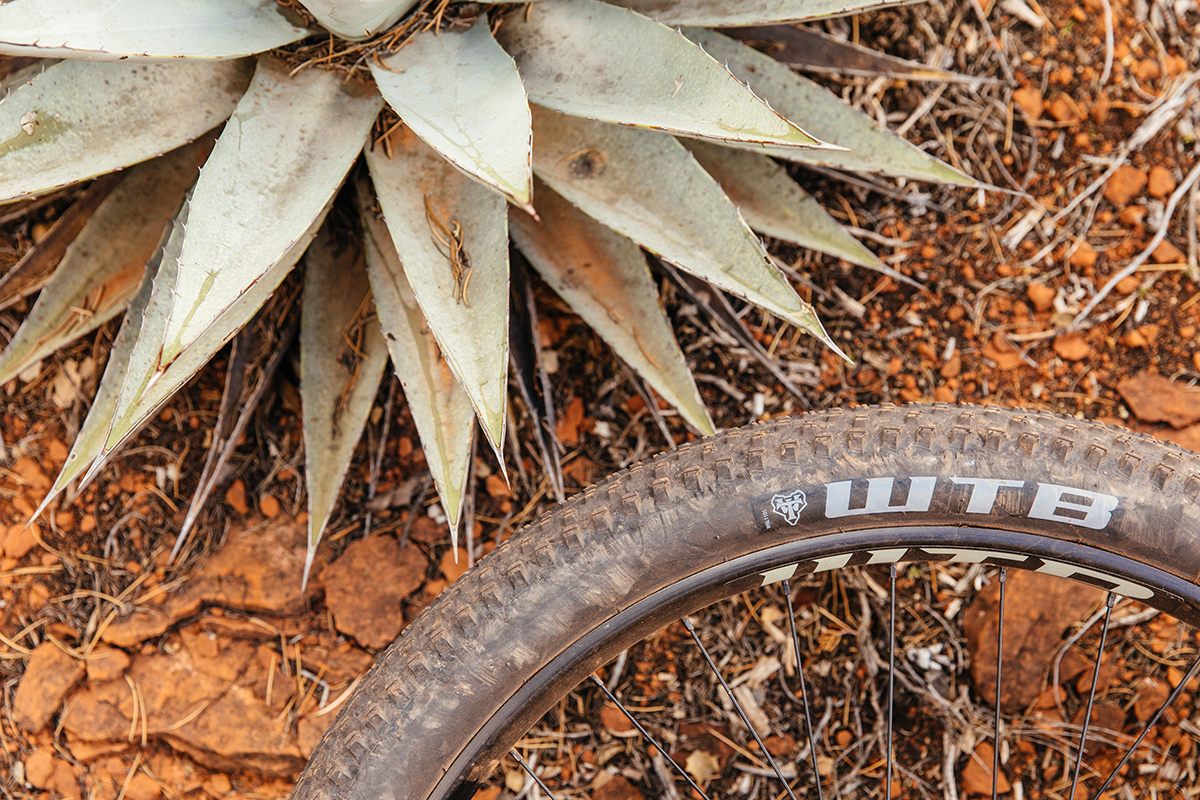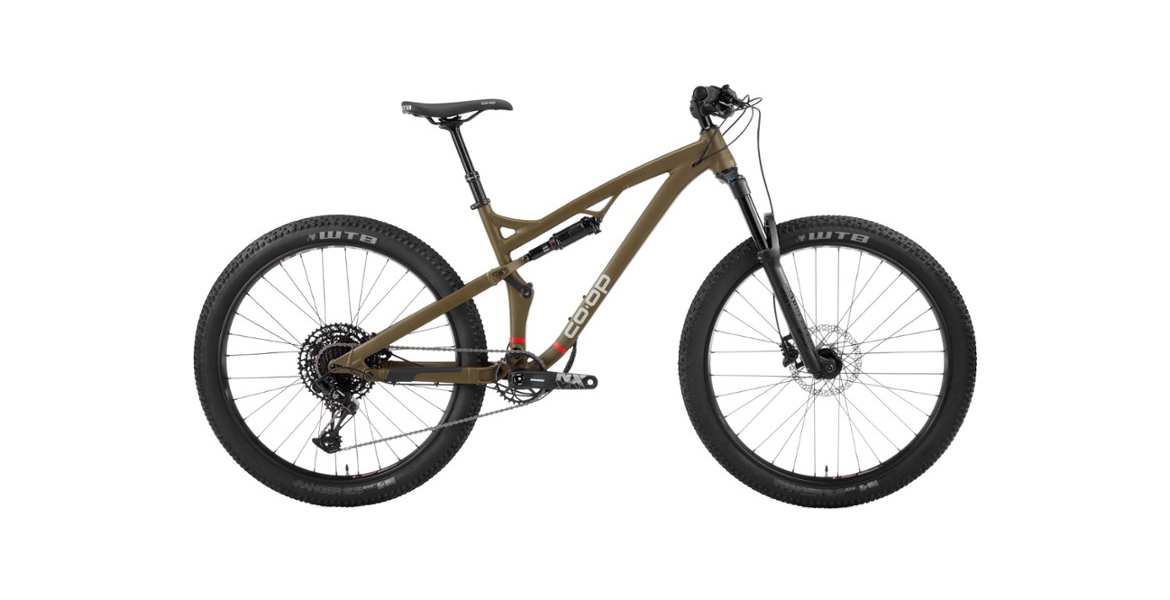Point and Go
Ever since Rocky Mountain Bicycles unveiled the full-suspension Sherpa a handful of springs ago as a purpose-built, plus-sized bikepacking bike, I’ve been intrigued by bikes sporting squish front and rear that offer a plausible bike travel platform. Rocky is rightly credited with pushing the envelope (along with WTB) on plus-size wheels and tires, and the brand’s relatively tucked-away suspension linkage left a reasonable amount of triangle space for a framebag.
REI’s Co-op Cycles DRT 3.2 may not have evolved directly from the Sherpa, but it certainly shares a common ancestor of an idea. Modern geometry (but not bleeding-edge progressive), modest travel (140mm front, 130mm rear on sizes medium and up — more on that later), big tires (27.5 x 2.8in), and a simple but effective Horst-link suspension tucked up into one corner of the front triangle add up to a bike that should ride well deep into the backcountry. As for unloaded in the front country? Oh yes, the DRT 3.2 rides very well indeed.
‘It was not designed for that … but it can do it’
Last month I joined a group of journalists and REI staff in Sedona, Arizona, to ride the brand’s new in-house–designed full-suspension mountain bike. We’d planned to meet in February, but snow in the desert turned the trails to sludge and demanded a change in plans. So this time we arrived to … cold rain and snow on the mesas? What is this place? Unseasonable weather indeed, but a little moisture provided hero dirt for our test rides, and a little cloud cover prevented my Montana complexion from turning the color of the sandstone spires.
Among our group of riders was REI’s Product Development Engineering Manager Steve Moenert, who, along with his team, designed to DRT 3.2 and its slightly less expensive sibling the 3.1. As the more bold among the group launched off a three-foot ledge, Moenert pointed out, “We didn’t design the bike for that, but it can do it.” He then proceeded to launch himself into space too.

Sum of its parts
And indeed, the DRT 3.2 was a capable rig, especially on Sedona’s ledgy, rocky, technical trails. I’m a plus-size–tire evangelist and have been riding 29 x 3.0in. rubber for years on a personal bike, and the 2.8in WTB Rangers were both very familiar and much appreciated on the unfamiliar terrain. I was concerned about the high-volume tires coupled with the mid-travel full suspension feeling a little wallowy, but the combo was complementary and the bike always felt solid while offering nearly endless traction.
SRAM’s NX Eagle group provides plenty of range with a 32T ring in front coupled with a massive 50T cog in the rear on the 3.2, and although the 3.1’s Shimano Deore drivetrain’s 28-42T combo gets low enough for luggage, that tiny chainring doesn’t offer much in the way of high-speed spinning. Shimano hydros provide plenty of stopping power, and while the X-Fusion Manic 150mm dropper post is extremely sensitive to seatpost clamp torque, it’s a proven, reliable unit, and speccing a dropper from the showroom floor regardless of price point is the mark of a product manager paying attention.
Nits
No bike is perfect, and where the DRT fell short for me was a too-narrow bar coupled with oddly shaped WTB grips that made for an uncomfortable cockpit. And, oddly, the position of the Monarch rear shock left the air valve slightly protruding on the drive side in a way that about half our group managed to scrape the inside of their right thighs on the metal cover. Otherwise, there’s not much I’d swap if it was my personal bike.
Sizing
A note on the DRT 3 series sizing — from medium up, the specs are noted here (I rode a size L). But for small and extra small, REI spec’d 26+ wheels and tires and shorter travel with 120mm front and rear. Extra small through medium also get 100mm of dropper post travel while large and XL get 150mm. The dropper is pretty self-explanatory — depending on your inseam, you might be well served by a swap (I was absolutely maxed at 150mm) — but the wheels are somewhat less clear-cut. Sizing down for smaller frames is becoming commonplace, and for good reason, but the 26+ size isn’t especially well supported in the industry so tire and wheel choice in the aftermarket will be limited. My advice would be for riders between and small and medium test both and consider whether cockpit adjustments might make the 27.5 size a good option.

Value
Though Co-op (neé Novara) has long been in the adventure and entry-level mountain bike space, the brand’s DRT line now stretches squarely into the mid-market with the 3.2 topping the line at nearly $3,000. But do customers really want a mid-level MTB from the outdoor giant when independent bike shops and consumer-direct brands offer a wide variety of options for the same chunk of change? Yeah, I think they might.
First, Co-op customers might be in REI already, and everyone likes a one-stop shop. But Co-op has also made a few more subtle decisions to amp up the value beyond a simple price check (and an annual dividend check!). Both full-squish DRTs come with tubeless-ready systems from WTB including pre-taped rims and tubeless-ready tires. A buyer need only swap in some valve stems and add sealant. That may not seem like much, but at this price point many bikes are more like tubeless-capable, but spec non-tubeless–ready tires to keep the price down. How important is that? Well, a 27.5+ tube weighs almost a pound, and when you’re talking about rolling weight, that’s a big deal. Bottom line: plus-size bikes are considerably worse with tubes in the tires. REI knows this and wants to make it as easy as possible to fix.
Second, the DRT 3.2 is an all-rounder. A custom-designed Revelate framebag will be available to maximize space in the frame if you want to load up, and a huge range of riders will find the mid-travel, plus-tire combo to be a riot wherever they live and no matter their experience level.
Last year I visited Sedona on my own and shipped my personal mountain bike so I could take my (let’s be honest, very silly) carbon wonderbike on the area’s famed trails. Riding them again on REI’s budget-friendly option was always going to make me wonder how much bike anyone really needs, but after having a helluva good time aboard the DRT 3.2, I’m honestly wondering how much bike I even want.


